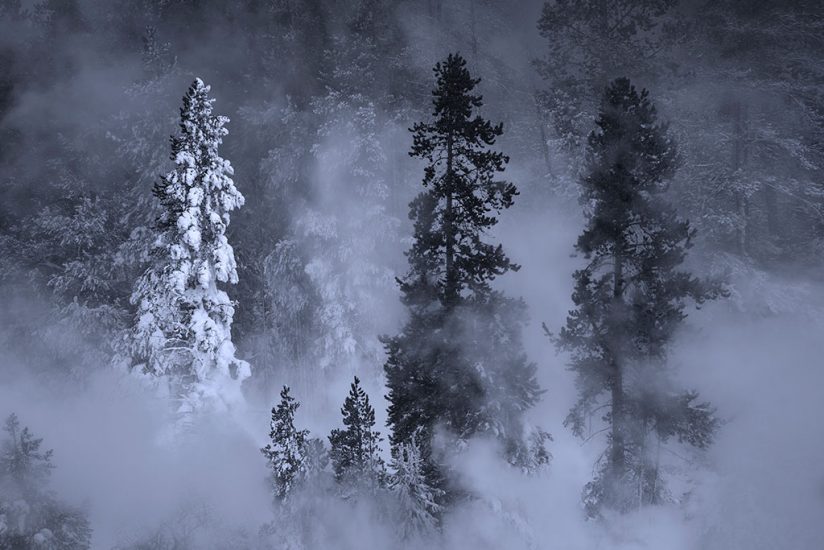
Apparition, Yellowstone National Park. This would not have been much of a composition in any other season. The juxtaposition of the dark trees with the white ice-caked one and the thick atmosphere and separation created by the mists of a nearby geyser were wholly the products of winter conditions. It should be noted that this was made on a partly cloudy, blue-sky day in the late morning. Isolating details of the landscape can create mystery from an otherwise unremarkable scene.
Depending on which poll you consult, most people’s favorite season is either spring, summer or fall. Regardless of the rankings at the top, one constant across these surveys is that winter places last by a noticeable margin. It is generally seen as bleak, colorless and depressing. I hope to show you that at least as far as landscape photography is concerned, it is anything but.
Among outdoor photographers, I would wager that autumn is the prevailing favorite, and for good reason. Most popular destinations are less crowded, the temperatures become comfortable for hiking around with heavy camera equipment, and, of course, visual contrasts and extravaganzas of color abound as foliage goes through its yearly transformation.
Earth is covered by 3 trillion trees, and as they change, so does the landscape. While I greatly look forward to autumn every year, as soon as I’ve had a good dose of colorful foliage and cooler temperatures, my heart and mind move on. I begin my eager anticipation of the first snows and the peaceful quiet of winter.
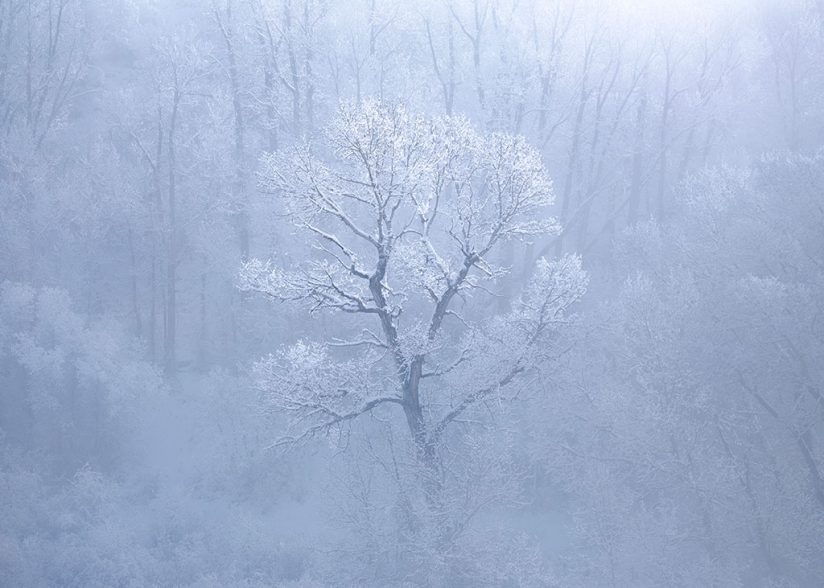
Ariandel, Colorado. I have seen this spot in the summer, and this particular tree is normally indistinguishable from its surroundings and backdrop. In fact, the whole scene is pretty mundane—just a thicket of green trees along the side of the highway. But on this particular morning, the combination of fresh snow, hoarfrost and fog at the moment the sun crested the ridge behind it created a magical atmosphere I have never seen replicated.
#1 Keep It Simple
There are a myriad of reasons to enjoy winter as a nature photographer, and perhaps the most obvious are the visual qualities it imparts upon the landscape. As photographers, our job is to simplify the world around us. This process of composition is not only the placement of the subject and the arrangement of forms but also the exclusion of extraneous elements from the scene before us. We do this so that our photograph may effectively convey what we want the viewer to see, free of distractions.
.jwplayer { margin-bottom: 20px; margin-left: auto; margin-right: auto; }
In this regard, winter offers us an advantage. There is perhaps no better natural simplification than snow. As it blankets the landscape, complex palettes of potentially clashing colors become a uniform white. Chaotic ground cover may become a sea of graceful, undulating mounds. Subjects may be simplified to their form alone, with their color and texture hidden from view. And all colors go well with white, so if any color is still visible in combination with the snow, it is likely to be a palette that works. Scenes that were previously too messy may now appear pristine.
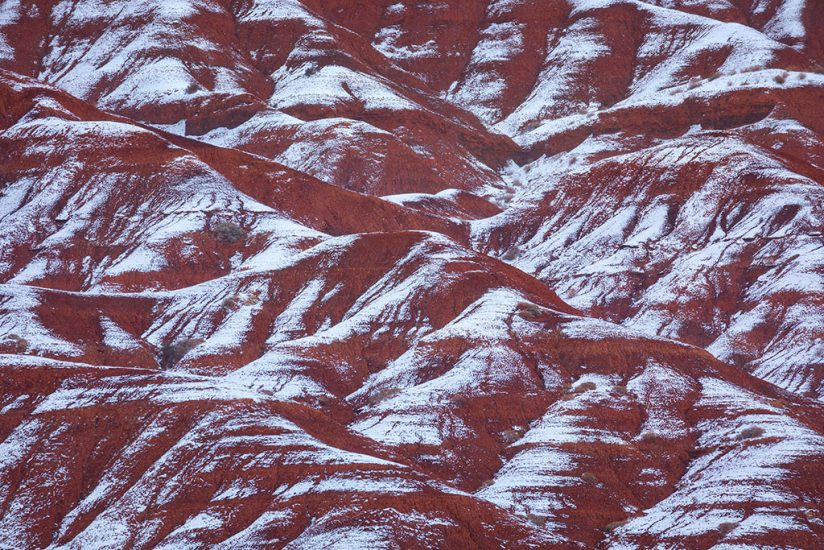
Frosted Clay, Capitol Reef National Park. I have passed by these red clay badlands at the foot of some very impressive cliffs many times on my drives in and out of one of my favorite national parks, and I’ve never been able to make a photograph that conveyed how they compelled me in person. But on this winter morning, that wasn’t necessary. A fresh dusting of snow created an entirely different opportunity, revealing a previously invisible pattern.
#2 Look On The Bright Side
Another positive effect of snow cover is that the landscape becomes much brighter. Why is that necessarily a good thing? Because our medium is light, and brighter objects are better at reflecting that light.
Many subjects in nature don’t lend themselves well to photography because they are too dark in relation to their surroundings. The viewer’s gaze is naturally drawn to luminosity, and it can be difficult to direct attention to your subject if it’s overpowered by the rest of the frame.
For example, take the Cascade Range of the Pacific Northwest in the summer. These peaks are composed of volcanic rock, which is quite dark (Mount Rainier’s impressively glaciated faces excepted), and in most mountain photographs, the peaks tend to be surrounded by much brighter sky. Thus, it can be difficult to make them stand out or to convey their interaction with light, since the lit surfaces of the mountain just don’t come to life as you’d hope during those magic hours at the edges of day, and the sky can easily overpower the intended subject.
But as soon as these peaks gain their winter coats, nearly any light can bring them to life, as the snow is highly reflective. Even better, the peaks no longer require intense light to glow; that can be achieved even with soft and diffuse light at the right time.
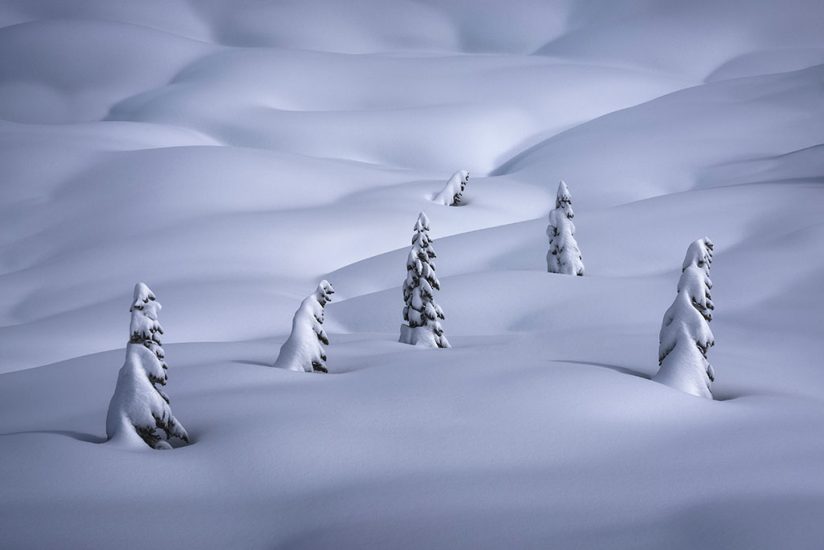
Hibernation, Mount Rainier National Park. This is one of my all-time favorite photographs, and it was not at all what I expected to find when I went for a rather strenuous overnight snowshoe with a friend. The goal was to photograph the mountain from a high vantage at sunrise, but this normally unassuming meadow near the trailhead provided my best image of the trip. It was covered in 13 feet of snow, leaving only the tips of massive conifers peeking out. The incline of the background hill gave the impression that the snowfield could be endless. A midday moment of diffuse spotlighting on an otherwise fully overcast day provided some dimension, while the neutral light and white snow gave the scene a very stark, pure and refreshing appearance.
#3 Think Snow
This brings me to perhaps the most striking visual quality of the winter landscape, also related to its interaction with light. Snow, with its high reflectivity and neutral white color, will take on qualities of the light that lands upon it, and not just luminosity but color also.
Take, for example, the blazing red sunrise and sunset skies so many landscape photographers pursue. In winter, these skies may no longer be simple filler for the top of the frame above the horizon; they bathe the landscape below in their colorful glow.
When the landscape is sporting its winter coat, it will reflect the properties of the light show occurring above, creating visual interest throughout the frame. The sky may not need to be included at all to convey the splendor of this event, and new compositional possibilities are thus unlocked outside of the standard formula. This also applies to the daytime blue sky, which is reflected particularly well in shaded snow. Pure, refreshing blue-and-white color palettes are no longer limited to sea and sky; they become available on the land itself.
As an aside, the way snow interacts with light also applies to sand, and that is one of the main reasons I love photographing dunes. It just so happens that winter is a wonderful time to visit warmer climates like the desert. The weather becomes pleasant, and fleeting winter conditions can present unique contrasts in a landscape normally associated with heat.
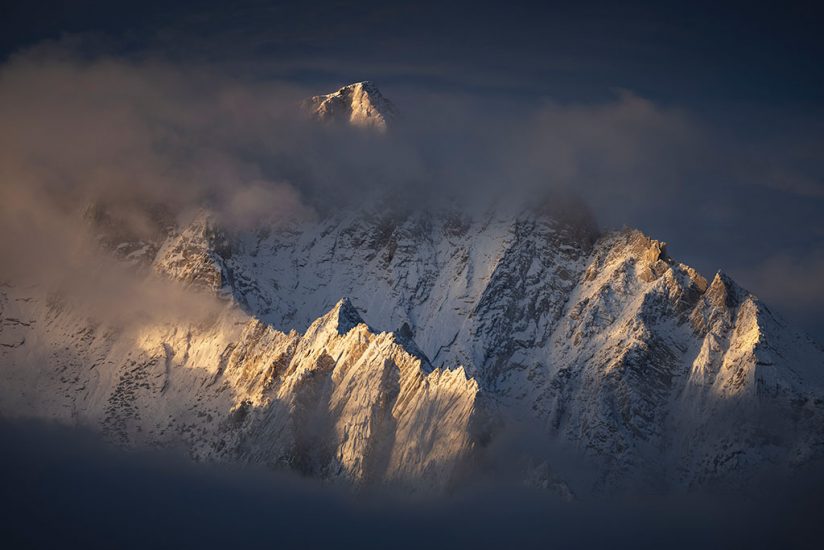
Mountain Aerie, Eastern Sierra Range. I wish I had a grand story to relay for this photograph, but in truth, I made it from my home. (I live full-time in a travel trailer.) I was parked in California’s famous Alabama Hills, and the first snow of the season fell overnight, prompting me to make the arduous 15-foot trek from my bed to my dinette. This is the famous Lone Pine Peak, but its winter coat and the clearing snowstorm partially shrouding it gave it more of a Himalayan appearance to my eye. Since I was using a telephoto lens to isolate the interesting moments happening around certain peaks, it didn’t really matter what my perspective was, and so I stayed warm in my pajamas, pointing my lens out the screen door.
#4 Winter Is A Wonderland
Winter is also host to a number of unique ephemeral conditions, which can transform a normally mundane landscape into a wonderland. On still nights with moist air, as the temperature falls below freezing, tiny ice crystals may condense on small branches and foliage, coating them in hoarfrost, which rewards those who wake up early enough to photograph it.
Any frozen puddle or pond may become a photographer’s playground with the cracks, bubbles and textures that form in ice. New shapes, contrasts and even optical illusions may appear as snow clings to the contours of the landscape and as it melts away in patches. Fog, another great simplifier of the landscape, is often prevalent in winter, and it may be combined with any of the aforementioned displays of light or atmosphere for truly magical potential.
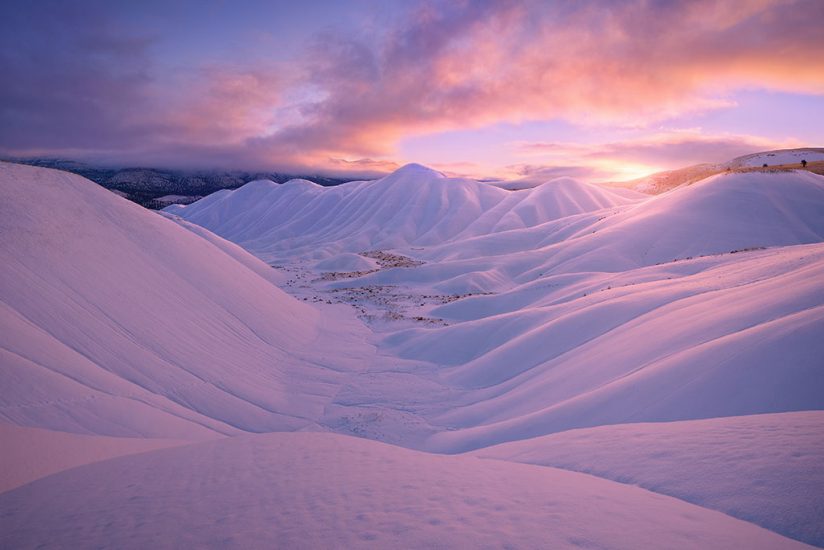
Painted White. This photograph was made on a -12-degree Fahrenheit morning after a dumping of fresh snow on one of Oregon’s most famous landmarks, the Painted Hills. Normally known for their colorful stripes, the hills were distilled down to their undulating forms with this rare winter coat, allowing the color and brilliance of the sunrise light to steal the show.
#5 Embrace The Quiet
Beyond the visual qualities that winter imparts upon the landscape, there are other advantages for us as nature photographers. In contrast with event photography, for example, we may prefer to work alone, free of distractions. I personally feel most at peace when I’m lost in my viewfinder, composing an image, the only sound an occasional breeze or the shuffling of my own feet. It is in this silence that I make my best photographs, and winter makes these opportunities more plentiful.
Winter is the true off-season for most outdoor destinations. Even the most popular national parks, still bustling with activity in other seasons, fall quiet in winter. People hibernate in their homes, focus on their family and the holidays, and concentrate on their work rather than on their vacations. Their absence is our gain. Even highly developed natural areas may become quieter as snow mutes the sound of tires on nearby highways.
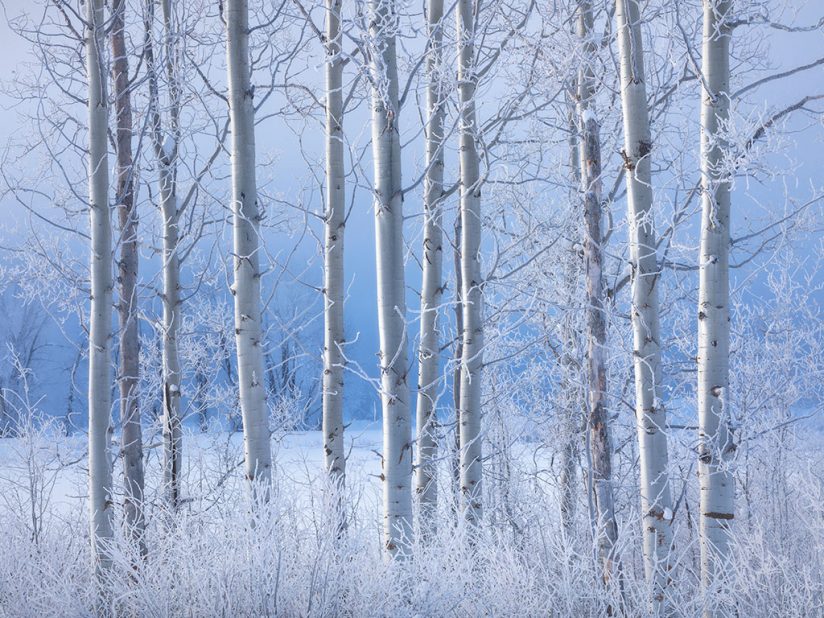
Twenty Below, Grand Teton National Park. The air was humid this morning, and the temperature was -20 degrees Fahrenheit. Fog dotted the area, and my friend and I were delighted to see that hoarfrost had transformed the landscape overnight. We excitedly drove to an area full of nice aspens. I got out of the car, took one breath, and…I was blind. My first exhalation outside the vehicle had instantly frozen on my glasses. No problem, I thought, I’ll just take them off. Except it turns out that if you’re normally nearsighted, you of course still can’t see through a DSLR’s viewfinder. OK, maybe I’ll use the rear LCD in Live View. Oops! I had already breathed on that, too, and it was coated in ice. So, this photograph was composed by alternating between lowering the camera and squinting, and then lining up the blurry grouping of trees symmetrically in my viewfinder. I didn’t see the details until later.
#6 Minimize Distractions
Having a peaceful working environment is not the only way winter increases the potential for photographic success. In the Northern Hemisphere, the winter sun is farther south, and so it makes a lower arc across the sky, increasing the amount of time we have access to the directional light that makes the so-called golden hours so special.
Nights are also longer in the winter, which is a big advantage if you’re like me and have difficulty getting enough sleep before waking up in darkness to go photograph sunrise. While landscape photography always involves some challenges, in my opinion, it’s important to minimize distractions to remain mentally present and enable creativity. I will concede that being cold may be one such distraction, but that is why we dress for an outing.
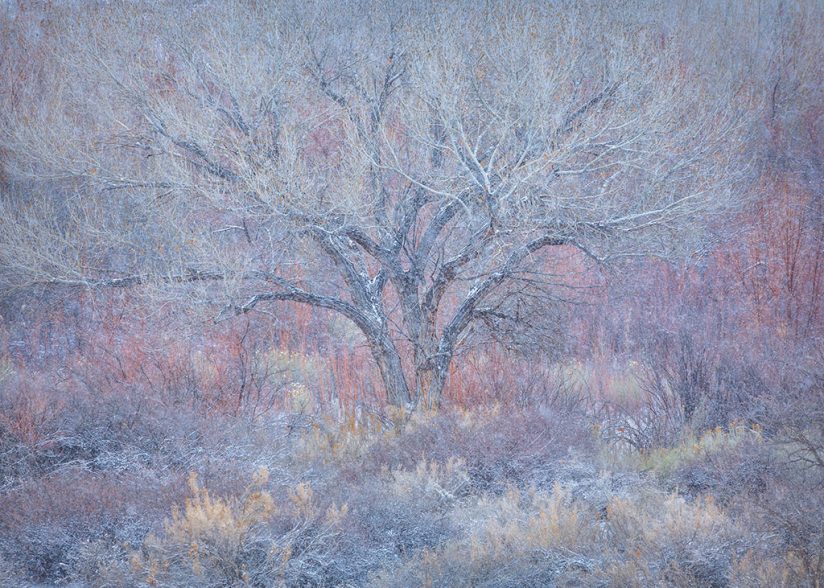
#7 Get Inspired
Lastly, and perhaps most importantly, I simply feel most inspired by winter. I may be an outlier—it seems seasonal affective disorder afflicts me in the summer—but I prefer cloudy skies and cold temperatures.
I enjoy the dynamic opportunities winter weather provides for nature photography. I prefer peace and quiet over excitement. I strive to make photographs that most photographers have not made and that most people will never witness firsthand. It seems to me that these unique opportunities might be more likely to occur in what is generally the least-popular season.
It is often said that a great photographer could make a good photograph of any subject, no matter how mundane. While that may be true to a degree, I think this idea misses the importance of inspiration in our work. We need to feel interested in our subject to connect with it and to engage our creative faculties fully.
As much as I appreciate backpacking in the mountains in the summer or walking on carpets of fallen leaves in autumn, there is always a part of me yearning for winter. When it finally arrives each year, I feel at peace, ready to savor the present. I make sure my camera is ready to help me capture that feeling so that I may return to it for years to come.
See more of Alex Noriega’s work at alexnoriega.com.
<!–  Text & Photography By Alex Noriega –>
Text & Photography By Alex Noriega –>